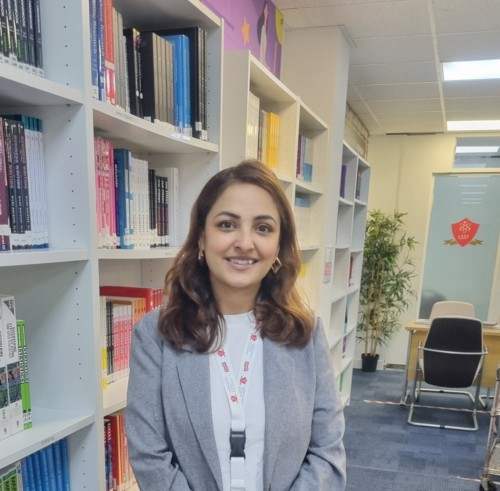A Journey of Connection, Growth and Purpose at LSST
Article Date | 10 October, 2025
Lighting the Fire of Education
“Education is not the filling of a pail, but the lighting of a fire.” – William Butler Yeats
This quote reflects the quiet and lasting impact of teaching, something I have come to understand and appreciate deeply throughout my time at LSST.
My journey at LSST began as an Academic Support Tutor, where I helped students navigate the complexities of academic life. I provided guidance in developing critical study habits, understanding assignment expectations, structuring arguments, and building academic confidence. It was in this role that I truly saw the wide range of struggles students face and how even the smallest encouragement can reignite their belief in themselves. This experience allowed me to understand students’ challenges from a supportive and empathetic perspective.
The more I worked with our students, the more this realisation grew within me: I no longer wanted to remain in the background. I wanted to step forward to be in the classroom, guiding and learning with them. I wanted to shape those moments where understanding and confidence return. This realisation wasn’t fleeting; it became a sense of purpose that led me to pursue lecturing as a path of meaningful impact. Stepping into the role of an LSST Lecturer gave me that opportunity, and it has since become more than a job; it is a calling that continues to shape who I am.
Learning from LSST’s Mature Students
At LSST, many of our students are mature learners. They return to education after long absences, carrying the weight of real-life responsibilities, full-time jobs, parenting, health challenges, and more. Despite these pressures, they arrive in the classroom determined, hopeful, and ready to learn. Watching them show up week after week with such resilience has profoundly shaped not only how I teach, but how I see education itself.
Before meeting students, I saw education largely as a structured process, a sequence of teaching, assessment, and outcomes. But my mature learners changed that completely. They taught me that education is not one-directional; it is mutual. It is not something we deliver; it is something we create together.
One moment remains etched in my memory: a student, a mother of three, once stayed behind after class. With quiet tears, she told me she had almost withdrawn from the course because she felt “too old to learn again.” Yet that day, she had presented her work with confidence for the first time. “You reminded me that I still can,” she said. It was in that moment that I realised that education isn’t just about knowledge; it’s about rekindling belief.
Another memory I carry deeply is of a mature student who began her Foundation Level journey terrified and unsure. She was older than most of her peers and confessed on her first day that she barely knew how to use a computer. Every task seemed daunting; every digital submission overwhelming. Yet, she never gave up. Step by step, she learned, asked questions, and slowly built her confidence. By the end of the semester, she had successfully submitted and passed all her assignments. When she came to collect her feedback, she hugged me tightly and said, “Thank you for giving me a second life. You believed in me when I doubted myself.”
That moment nearly brought me to tears. It reminded me that being a lecturer is not just a profession; it is a privilege. We hold the power to touch lives in ways that go far beyond the classroom. It is not about showing students how strict or authoritative we can be; it is about helping them shape their lives with confidence, compassion, and the knowledge they gain through our support. The joy that comes from witnessing such a transformation is incomparable; it is what makes this journey truly fulfilling.
Each student brings something powerful to the classroom: authenticity, resilience, or a quiet determination to improve. Many of our mature learners display extraordinary commitment. They juggle multiple roles and still make time for education, showing that growth can happen at any age, under any circumstances. Their stories, some filled with personal loss, others with renewed hope, challenge conventional ideas about who belongs in education. They remind me that the most meaningful learning often comes from lived experience, not just textbooks (Knowles et al., 2015; Illeris, 2018).
When Students Become Teachers
Working with mature students has revealed something profound: teaching is never one-directional. It is a two-way process, a journey of mutual growth, trust, and discovery. My students do not just receive information; they breathe life into it. They engage critically with the material, challenge assumptions, and enrich our conversations with real-world experience. Their questions are not simply about clarity; they are about meaning.
Through them, I have learned as much as I have taught. Their courage and wisdom have expanded my worldview, reshaped my teaching, and deepened my empathy. They have taught me to listen more, to adapt more, and to appreciate that learning flows both ways. I no longer see myself as a dispenser of knowledge, but as a partner in their learning journey. Each interaction challenges me to remain curious, reflective, and humble, qualities that continue to educate me.
Meaningful education is not just about outcomes or presentations; it lives in the moments when students connect ideas to their own lives, when a concept truly resonates. Making learning relevant to their reality makes it last. This requires more than academic preparation; it requires heart. It means offering flexibility when someone is caring for a loved one, extra guidance when confidence wavers, and patience when life intervenes (Niemiec & Ryan, 2009; Jennings & Greenberg, 2009).
Good teaching, I have come to believe, is not about presenting the right answers. It is about nurturing the right questions, creating space for vulnerability, and listening with empathy. It is about helping someone rebuild their belief in themselves one lesson at a time (Jennings & Greenberg, 2009).
From Delivering to Connecting
In the early stages of my lecturing journey, my approach was highly structured. I focused heavily on planning, content delivery, and assessment criteria, a model rooted more in formality than flexibility. However, real classroom experiences quickly taught me that education is not a transactional process. It is not enough to provide students with information and expect progress.
Real learning emerges through emotional connection, shared understanding, and trust, qualities that lie at the heart of educational ethos. At LSST, we believe in education as transformation: not just the pursuit of academic success, but the empowerment of individuals through empathy, inclusion, and community.
As I gained confidence and insight, I began to see how critical it is to understand the learner as a whole. Students are not empty vessels; they come with backgrounds, perspectives, fears, and ambitions. Recognising this shifted how I teach. I now build time for dialogue, reflection, and student-led exploration into my sessions, because the most powerful lessons often emerge from shared conversation, not a slide deck.
This evolution in my practice reflects Brookfield’s (2017) vision of the critically reflective teacher, someone who not only teaches but learns from every student interaction, adapting continuously to meet the evolving needs of their learners.
Education as Empowerment
To teach is to empower not only academically, but also emotionally and personally. At LSST, I have witnessed how education can become a profound turning point in people’s lives. For those who once felt left behind by the system or doubted their own abilities, education offers something beyond qualifications; it offers hope. It becomes a means of rediscovering self-worth, rebuilding resilience, and rewriting one’s own story.
This transformation is often quiet but powerful: in the trembling voice of a student who speaks in class for the first time; in the message that reads, “I didn’t think I could do this, but I did.”
These are not abstract ideals; they are real human experiences I have been privileged to witness. I have seen pride in a student’s eyes when they conquer a difficult topic. I have celebrated the silent victories of those who pass modules after nearly giving up. And I have stood in awe of learners who, through education, discover not just new careers, but new versions of themselves.
The classroom, to me, has become more than a place of instruction. It is a place of transformation, a space where resilience is nurtured and where voices long unheard find their strength. Every lesson carries the potential to uplift, and every small success is a quiet revolution, proof that learning truly empowers change (Busher & James, 2019).
Gratitude and Growth
This journey has not only refined my teaching but transformed who I am at my core. I have become more empathetic, more attentive, and more human in how I approach education. I have learned that some of the most meaningful changes occur in silence, in the perseverance of a student who refuses to give up, in the confidence quietly rebuilt, and in the courage it takes to start again after years away from learning.
The true power of teaching lies in these everyday interactions: a nod of encouragement, an open discussion, a shared moment of understanding. These are the sparks that light the fire of transformation. Each lecture is not just a lesson plan; it is an opportunity to make someone feel seen, supported, and capable of more than they believed.
I am sincerely grateful for the environment that has made this growth possible. The unwavering support from LSST has created space for reflection, experimentation, and trust. The kindness, collaboration, and shared dedication of my colleagues have given me strength during challenging moments and joy during triumphs. Most importantly, my students have inspired me through their honesty, perseverance, and quiet strength.
I move forward with humility and renewed purpose, committed to learning from every student I meet.
In every classroom, I see not just potential, but purpose, and that keeps me learning too.
That, to me, is the true heart of education at LSST.
References
Brookfield, S.D. (2017). Becoming a Critically Reflective Teacher (2nd ed.). San Francisco: Jossey-Bass.Busher, H. and James, N. (2019). ‘The continuing professional development of teachers: Issues of coherence, cohesion and sustainability’, Professional Development in Education, 45(1), pp. 1–3. Illeris, K. (2018). Contemporary Theories of Learning: Learning Theorists … In Their Own Words. 2nd edn. London: Routledge.
Jennings, P.A. and Greenberg, M.T. (2009). ‘The Prosocial Classroom: Teacher Social and Emotional Competence in Relation to Student and Classroom Outcomes’, Review of Educational Research, 79(1), pp. 491–525.
Knowles, M.S., Holton III, E.F., & Swanson, R.A. (2015). The Adult Learner (8th ed.). Routledge.
Niemiec, C.P. & Ryan, R.M. (2009). ‘Autonomy, competence, and relatedness in the classroom: Applying self-determination theory to educational practice.’ Theory and Research in Education, 7(2), 133–144.
Patall, E.A., Cooper, H. and Wynn, S.R. (2010). ‘The effectiveness and relative importance of choice in the classroom’, Journal of Educational Psychology, 102(4), pp. 896–915.




